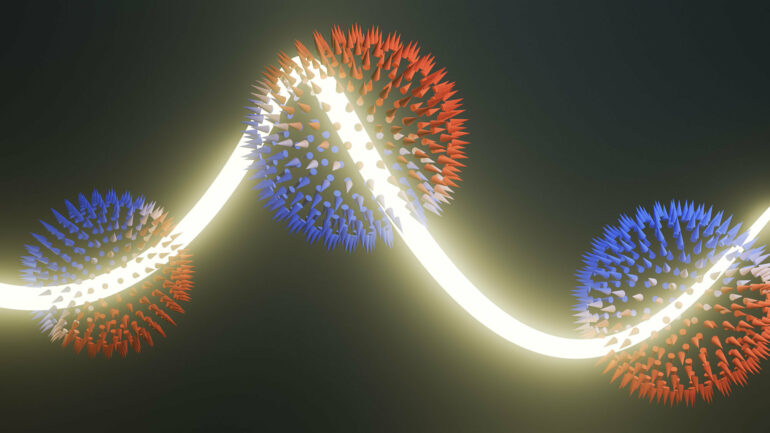Orbital angular momentum monopoles have been the subject of great theoretical interest as they offer major practical advantages for the emerging field of orbitronics, a potential energy-efficient alternative to traditional electronics. Now, through a combination of robust theory and experiments at the Swiss Light Source SLS at Paul Scherrer Institute PSI, their existence has been demonstrated. The discovery is published in the journal Nature Physics.
Whereas electronics uses the charge of the electron to transfer information, technology of the future with less environmental impact might use a different property of electrons to process information. Until recently, the main contender for a different type of ‘tronics’ has been spintronics. Here, the property used to transfer information is the spin of the electron.
Researchers are also exploring the possibility of using the orbital angular momentum (OAM) of electrons orbiting their atomic nucleus: an emerging field known as orbitronics. This field holds great promise for memory devices, particularly because a large magnetization could potentially be generated with relatively small charge currents, leading to energy-efficient devices. The million-dollar question now is identifying the right materials to generate flows of OAMs, a prerequisite for orbitronics.
Now an international research team led by scientists from Paul Scherrer Institute PSI and Max Planck Institutes in Halle and Dresden in Germany have shown that chiral topological semi-metals, a new class of materials discovered at PSI in 2019, possess properties that make them a highly practical choice for generating currents of OAMs.
Chiral topological semi-metals: a straightforward solution for orbitronics
In the search for suitable materials for orbitronics, steps forward have already been made using conventional materials such as titanium. Yet since their discovery five years ago, chiral topological semi-metals have become an intriguing contender. These materials possess a helical atomic structure, which gives a natural ‘handedness’ like the DNA double helix and could naturally endow them with patterns or textures of OAM that enable its flow.
“This offers a significant advantage to other materials because you don’t need to apply external stimuli to get OAM textures—they’re an intrinsic property of the material,” explains Michael Schüler, group leader in the Center for Scientific Computing, Theory and Data at PSI, and assistant professor of physics at the University of Fribourg, who co-led the recent study. “This could make it easier to create stable and efficient currents of OAM without needing special conditions.”
The attractive but elusive prospect of orbital angular momentum monopoles
There is one particular OAM texture, hypothesized in chiral topological semi-metals, that has captivated researchers: OAM monopoles. At these monopoles, OAM radiates outwards from a center point like the spikes of a scared hedgehog curled into a ball.
Why these monopoles are so tantalizing is that OAM is uniform in all directions: i.e. it is isotropic. “This is a very useful property as it means flows of OAMs could be generated in any direction,” says Schüler.
Yet despite the attraction of OAM monopoles for orbitronics, until this latest study, they have remained a theoretical dream.
Hedgehogs hide between theory and experiment
To observe them experimentally, hope has lain with a technique known as Circular Dichroism in Angle-Resolved Photoemission Spectroscopy, or CD-ARPES, using circularly polarized X-rays from a synchrotron light source. Yet a gap between theory and experiment has in the past hindered researchers from interpreting the data. “Researchers may have had the data, but the evidence for OAM monopoles was buried in it,” says Schüler.
In ARPES, light shines on a material, ejecting electrons. The angles and energies of these ejected electrons reveal information on the electronic structure of the material. In CD-ARPES, the incident light is circularly polarized.
“A natural assumption is that if you use circularly polarized light, you are measuring something that is directly proportional to the OAMs,” explains Schüler. “The problem is, as we show in our study, this turns out to be a somewhat naïve assumption. In reality, it’s rather more complex.”
Rigor plugs the gap
In their study, Schüler and colleagues examined two types of chiral topological semi-metals at the Swiss Light Source SLS: those made of palladium and gallium or platinum and gallium. Determined to reveal the OAM textures hidden within the complex web of CD-ARPES data, the team challenged every assumption with rigorous theory.
Then they took an unusual, and crucial, extra experimental step of varying the photon energies. “At first, the data didn’t make sense. The signal seemed to be changing all over the place,” says Schüler.
Meticulously unpicking how different contributions complicated calculations of OAM from CD-ARPES data, they revealed that the CD-ARPES signal was not directly proportional to the OAMs, as previously believed, but rotated around the monopoles as the photon energy was changed. In this way, they bridged the gap between theory and experiment and proved the presence of OAM monopoles.
Doors open to exploring orbital angular momentum textures in new materials
Armed with the ability to accurately visualize OAM monopoles, Schüler and colleagues went on to show that the polarity of the monopole—whether the spikes of OAMs point inwards or outwards—could be reversed by using a crystal with a mirror image chirality. “This is a very useful property, as orbitronics devices could potentially be created with different directionality,” says Schüler.
Now, with theory and experiment finally united, the wider research community are equipped with the means to explore OAM textures across a variety of materials and optimize their applications for orbitronics.
More information:
Controllable orbital angular momentum monopoles in chiral topological semimetals, Nature Physics (2024). DOI: 10.1038/s41567-024-02655-1
Provided by
Paul Scherrer Institute
Citation:
Orbital angular momentum monopoles discovery propels orbitronics forward in energy-efficient tech (2024, September 27)



